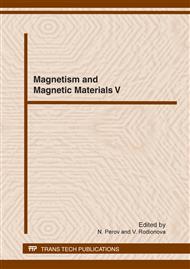p.291
p.295
p.299
p.303
p.307
p.311
p.315
p.319
p.323
Magnetic Field and Annealing Influence on the Martensitic Transition in Ni45.8Mn42.6In11.6 Shape Memory Alloy Ribbons
Abstract:
We report the effect of shorttime vacuum annealing, during 10 minutes at 923 K, 973 K, 1023 K and 1073 K, on magnetostructural properties of as-quenched ribbons of Ni45.5Mn43In11.5 Heusler alloy. The martensitic transformation is strongly sensitive to annealing treatments. The martensitic phase starting temperature is significantly shifted from 239 K towards higher temperatures around 370 K. It suffers a break down in two peaks when a field equal or higher than 500 Oe is applied to the as-quenched sample. This effect is not detected in the transformation of annealed ribbons but its signature can be observed at low temperature. Moreover, under high magnetic field up to 30 kOe temperatures associated with both martensitic and reverse transitions do not change for annealed samples, meanwhile the magnetization difference between austenite and martensite increases with the field. Nevertheless, it almost remains unchanged in the as-quenched ribbon.
Info:
Periodical:
Pages:
307-310
Citation:
Online since:
June 2012
Price:
Сopyright:
© 2012 Trans Tech Publications Ltd. All Rights Reserved
Share:
Citation:


